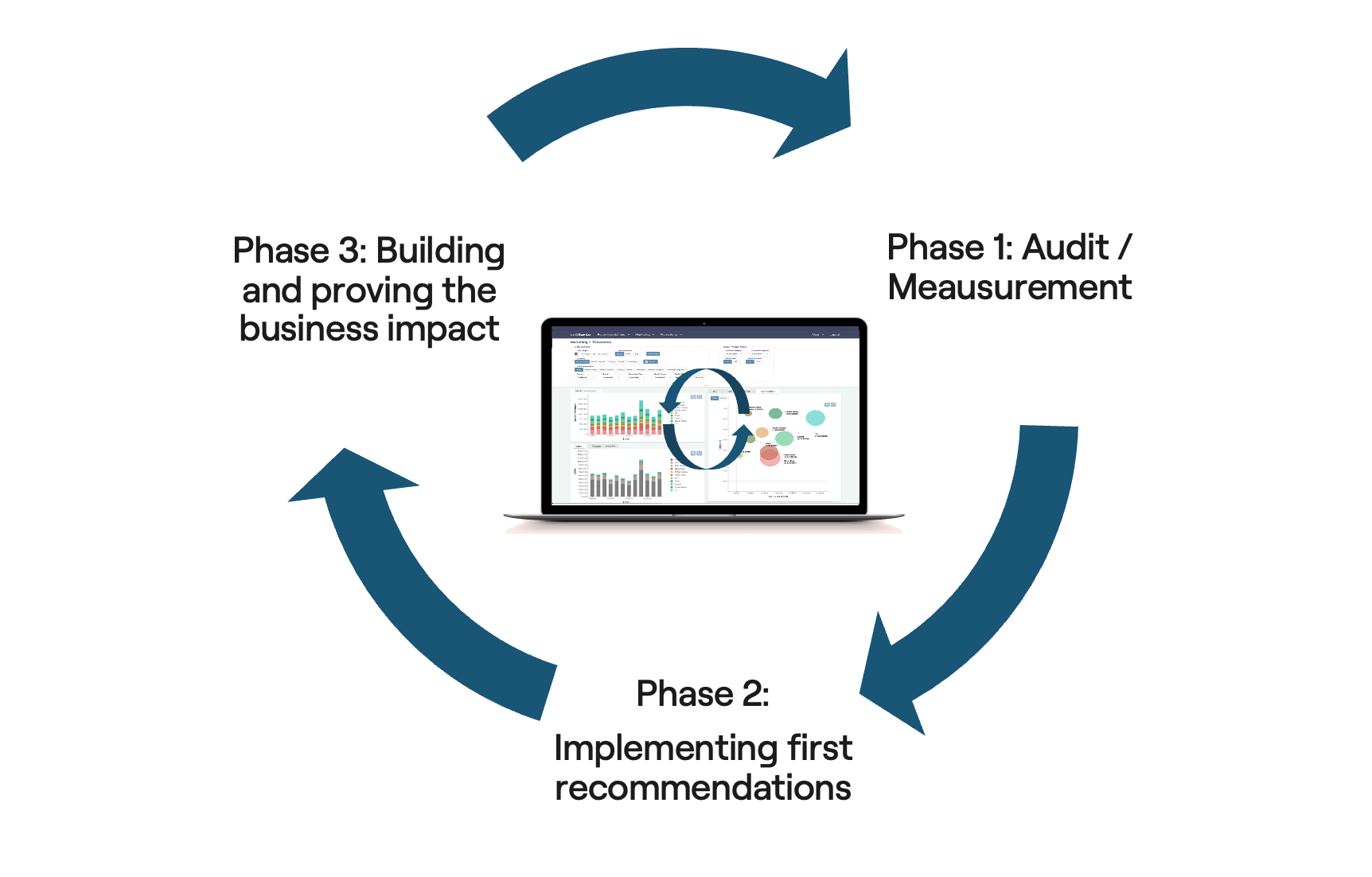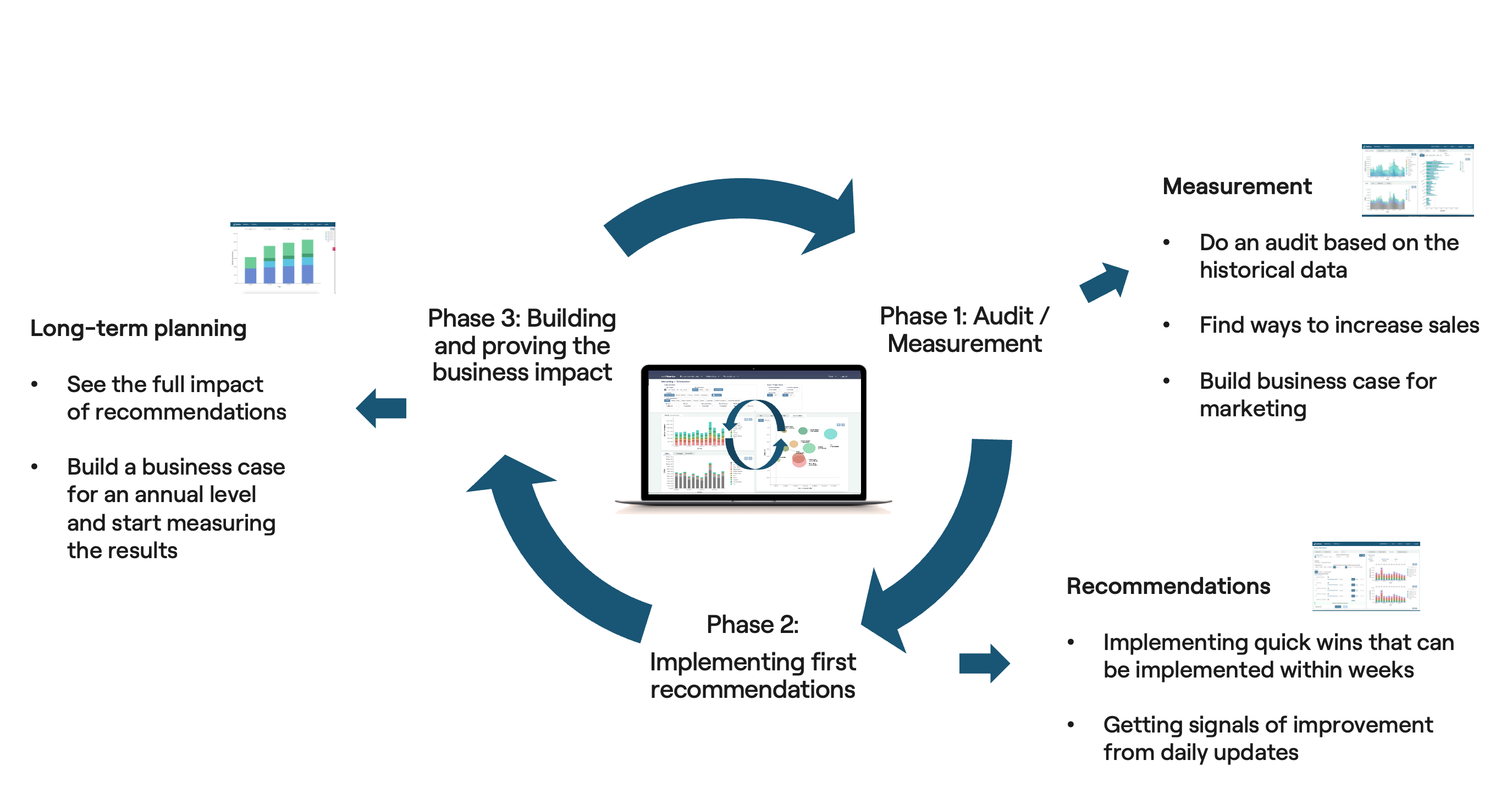Blog
How agencies can benefit from continuous MMM?
January 23, 2024 | Eeva Karhu, Paul Arpikari, Carmen Bozga

Continuous Marketing Mix Modeling (MMM) operates as a Software as a Service (SaaS) solution as a close to real-time tool to measure marketing performance and forecast selected business KPIs (most often sales). For agencies it serves as an anchor measurement providing a zero starting point, supports target setting and strategic planning process, and offers directional guidance from a business case perspective. Without continuous MMM, agencies often only have isolated studies, snapshots from one particular moment, with no chance of seeing the full business impact soon after the action. A continuous approach allows agencies to see where they are today and to set targets from annual to weekly levels, acting as a roadmap for their marketing efforts.
The three Phases of Continuous MMM
To fully understand the advantages of continuous MMM over traditional, one-off MMM projects, it's essential to examine the three core phases of continuous MMM.

1) Audit & Measurement.
The first phase, Audit & Measurement, is a comprehensive process where agencies delve into historical data to find ways to improve efficiency. This phase is foundational, as it sets the groundwork for all subsequent decision-making and strategy formulation. It begins with the collection and analysis of historical data, encompassing sales figures, marketing expenditures, customer interactions, and market trends. From the Audit & Measurement Phase you should get:
Overview of historical results:
- A comprehensive analysis of different marketing channels and campaigns, evaluating their individual and combined effects on sales and other Key Performance Indicators (KPIs).
- Develop a business-case perspective for marketing objectives and identify strategies to boost sales.
- Ensure transparent and effective communication between media planners, and between the client and agency.
2) Recommendations
In the second phase of continuous MMM, Strategy & Implementation, agencies transition from analysis to action. Armed with the insights gleaned from the initial audit and the MMM solution, they begin to prioritize and allocate resources more effectively. Typically it’s good to separate things to change for two different groups: smaller & easy-to-implement and bigger & harder-to-implement. To gain trust for the results, agencies and end customers should typically start with these smaller & easy-to-implement changes where it’s easy to see the benefits within weeks of the changes.
Overview of optimization insights:
- Shift from analysis to implementation; modify investment levels in media groups, channels, and bidding strategies weekly.
- Engage in scenario planning to achieve targets. For example, determine the potential increase in sales with a 5% budget increase. Explore strategies for maximizing sales within the existing budget. Assess the minimal impact on sales when faced with a 3% budget reduction.
- Analyze campaign performance; efficiently consolidate and examine data from various channels (both online and offline), and develop a comprehensive, media-specific view of campaign effectiveness.
3) Long-term business plans
This phase enables agencies to evaluate the comprehensive impact of their strategies and refine their methods to align with long-term objectives. This entails more of the mentioned bigger & harder-to-implement changes compared to the second phase, which may involve, for instance, formulating an annual plan that is partially informed by MMM recommendations.
Overview of annual recommendations:
- Full overview and recommendations for annual media investment level and split over different products and brands
- A comprehensive evaluation of how different campaign types, marketing channels and strategies have contributed to overall sales and profitability
- How investments should be split over time to gain the maximum impact out of every marketing dollar
How is this different from earlier ground truth?
Continuous MMM is done in 95 % of the cases on top of the customer’s business data whereas earlier analyses done by agencies have been done mostly on Google Analytics Purchase revenue or similar.
Firstly, as the first party cookie consent rate is between 50-85 % between different countries, this already creates the situation where you will have the campaign’s effectiveness measured in a much bigger chunk of sales that will automatically lift media-driven sales and ROI.
Secondly, sometimes more importantly, your analysis and presented numbers will match with numbers on the customer side which automatically creates more trust in your numbers as the results always need to be sold internally further and this is a big help to your stakeholder in the customer side.
Thirdly, you will have insights that you’ve missed previously: Numbers will include facts like returning rates (sales after returns), profitability, last-click and MMM results comparison, media channels saturation points, etc.
The list of benefits doesn’t stop there, so we’ve created this list to see the top benefits for yourself and your customers:
- Real-Time Data Analysis for all media investments: Continuous MMM provides up-to-date data, allowing for timely and relevant insights about the impact and efficiency of each media group and channel.
- Dynamic Strategy Adaptation: Enables quick adjustments to marketing strategies based on current market conditions and consumer behavior.
- Cost Efficiency: Ongoing MMM is more cost-effective in the long run compared to one-time, extensive projects.
- Improved ROI Measurement: Continuous tracking and analysis lead to a more accurate understanding of return on investment for different marketing activities.
- Benchmarking and Comparative Analysis: Allows for ongoing benchmarking against industry standards and competitors.
- Enhanced Decision Making: Data-driven insights contribute to more informed strategic decisions.
- Identification of Low-hanging Fruits: Quick identification and capitalization on easy wins for immediate gains.
- Long-term Strategic Planning: Facilitates the development of long-term marketing strategies based on sustained data collection and analysis.
- Scalability of Successful Campaigns: Easy identification of successful strategies for replication and scaling.
- Continuous Improvement: Encourages a culture of ongoing refinement and optimization in marketing efforts.
- Efficient Resource Allocation: Enables more effective allocation of marketing budgets and resources based on real-time performance data.
- Minimized Risk: Continuous analysis and adjustment reduce the risk of large-scale marketing failures.
- Enhanced Cross-Channel Optimization: Ability to optimize marketing efforts across various channels simultaneously.
- Predictive Analysis: Utilizes historical data for predictive modeling, helping in forecasting future market trends and consumer behaviors.
- Holistic View of Marketing Performance: Provides a comprehensive view of the marketing mix and its overall impact on business objectives.
Challenges and Conclusion
In conclusion, continuous MMM represents not just a shift in methodology, but a transformative approach to marketing analytics and modern media planning. It offers agencies real-time insights, the ability to adapt quickly to market changes, and a data-driven path to achieving marketing objectives. By embracing continuous MMM, agencies can stay ahead in a rapidly evolving digital landscape, ensuring they are prepared to meet their clients' needs in a post-cookie world.
Curious to learn more? Book a demo.
Related articles
Read more postsNo items found!